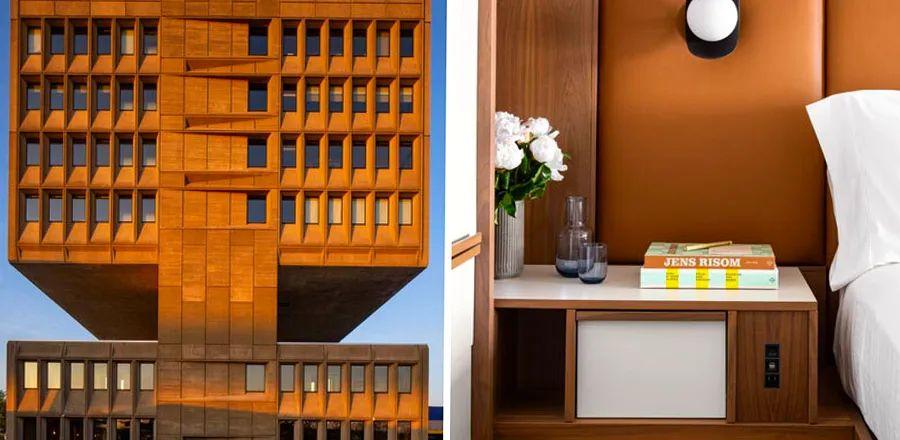Discover the Sustainable Hotel Everyone is Raving About

An old office building near a bustling highway interchange and an IKEA outlet may not seem like the ideal spot for cutting-edge hotel design in New Haven, Connecticut, or anywhere else in the U.S. However, for Bruce Becker, president of Becker + Becker, a property developer with a focus on sustainable design, this stark structure presented a prime opportunity for an eco-friendly architectural experiment.
Recently reopened after years of neglect, the Hotel Marcel is a 165-room refurbished venue hailed as the nation’s first net-zero hotel.
Though the hotel is still pending certification from leading efficiency organizations—the U.S. Green Building Council and the Passive House Institute—the term “net-zero” signifies buildings that produce as much energy as they consume, ideally utilizing renewable energy sources and efficient practices.
During my visit to the revamped hotel this summer, I immediately noticed signs of its energy initiatives at the entrance—three solar canopies. These canopies serve a dual purpose: they shield vehicles from becoming unbearably hot during peak summer while harnessing solar power to fuel the hotel throughout the year. They currently cover about two-thirds of the hotel's energy needs, and a future expansion across the parking area aims to boost that to over 80 percent.
"To build a truly sustainable structure, the key is to ensure it's fully electric," Becker stated while reclining on a vibrant coral couch in the Hotel Marcel’s lobby. He expressed confidence that the energy grid will transition entirely to renewable sources in the near future. "The only way to be certain of not impacting carbon emissions is to generate your energy on-site, which has been our guiding principle. It also makes financial sense by reducing ongoing costs, earning credits from utility companies, and qualifying for various subsidies," he added.
Additional solar panels adorn the hotel's rooftop, which Becker noted was too windy for a rooftop deck; these panels supply the final third of the property’s energy requirements. Although the roof experiences strong gusts, Becker and his team chose against installing small wind turbines, as the funds spent on such setups were better allocated to solar panel investments, which offered three times the value.
Thanks to Connecticut’s energy regulations, Hotel Marcel can sell any surplus electricity to the local utility. A room filled with battery racks on a guest floor stores additional power for times when demand spikes. Triple-glazed windows also contribute to lower energy consumption and mitigate noise, providing significantly better insulation compared to single-glazed options.
Minimizing energy consumption from laundry, dining, and elevators
Within the hotel—originally designed over 50 years ago by renowned architect Marcel Breuer, who created notable structures including a building for the Whitney Museum of American Art in New York City and the Atlanta Central Library—additional strategies are in place to decrease energy usage. This includes opting for electric appliances instead of traditional gas-powered ones, such as clothes dryers and kitchen equipment.
"Buying an electric clothes dryer costs about the same," Becker explained. "As long as we're generating enough electricity, it's essentially like having a free dryer instead of relying on natural gas." To lower the electricity demands of the fryer—the kitchen appliance that consumes the most energy—the hotel is crafting a menu with fewer fried options and dishes that require warmers. The fully electric kitchen aims to utilize local ingredients whenever possible to reduce transportation emissions.
Beginning in August, guests arriving by car will have access to two varieties of electric vehicle chargers: 12 Tesla Superchargers and 5 level-2 dual chargers. An electric shuttle service will transport guests to New Haven Union Station and several major attractions, including the Yale University campus, thereby reducing transportation emissions from tourists navigating New Haven's popular districts.
Even the elevators contribute to the net-zero mission, utilizing regenerative braking technology similar to that found in hybrid vehicles. This system captures excess energy produced during the elevator's ascent and descent, redirecting it back into the building’s power grid, effectively generating electricity as the elevator descends. The cost of implementing this technology has significantly dropped over the past two decades, making it a favored and effective approach for enhancing a building’s overall energy efficiency, according to Amy Blankenbiller, executive director of the National Elevator Industry, Inc.
To ensure the project's financial viability, Becker adhered to specifications outlined by federal and state historical preservation authorities, preserving the character of the hotel’s brutalist facade from the 1950s. Following these guidelines allowed for eligibility for financial preservation incentives and energy-related subsidies.
"Transforming an existing structure into a hotel is a highly sensible approach, as few buildings cannot achieve net-zero status," he remarked. "Modern energy systems are relatively straightforward to upgrade; you can simply replace a boiler with an electric heat pump and transition away from fossil fuels efficiently."
However, he observes that simple rectangular structures are more suitable for net-zero retrofitting compared to buildings with complex shapes that have extensive surface areas, which complicate energy efficiency improvements.
Chasing a Moving Target
Even with numerous upgrades and installations, maintaining net-zero status will require ongoing effort. Becker described this status as “dynamic,” resembling a moving target rather than a fixed goal. The energy demands of the property will evolve over time, influenced by guest behavior and occupancy levels. While energy patterns in office buildings and residential apartments are relatively stable, hotels attract visitors for countless reasons, leading to varied energy usage profiles.
Net-zero is something that can really only be defined for a specific timeframe," Becker explained. "After that, it needs to be measured again."
"Buildings with less predictable usage patterns, such as hotels, pose challenges because we can't forecast exactly how they will be utilized," noted Karen Walkerman, an independent energy efficiency consultant. She illustrates the scenario for properties like Hotel Marcel using computer models to project energy consumption based on various factors, including peak shower times, foot traffic, and when laundry appliances are most active. "We hope this hotel will be highly popular and consistently occupied, but we can't accurately predict that before the grand opening," she added.
But why not just plan for the maximum potential energy demand and either sell off or store any excess? "You can't continuously generate surplus energy and store it indefinitely; the cost of having enough batteries to hold that much power for one location would be prohibitively high," Walkerman explained. "While selling excess electricity might seem like a great solution, utility companies typically pay much less for electricity on the open market than what they charge customers."
Walkerman mentioned that the accuracy of initial energy models is also influenced by whether weather patterns align with earlier forecasts. However, she pointed out that her previous collaborations with Becker, such as transforming a former bank into an apartment complex, generally showed a strong correlation between the energy model and actual energy usage.
To ensure Hotel Marcel stays on track for its net-zero status, she plans to adjust her models using data like utility bills and occupancy rates at 6 and 12 months post-opening. If the hotel’s energy consumption exceeds expectations, Becker indicated he would likely explore adding more solar canopies as needed.

Photo by Seamus Payne
According to a 2021 sustainability study by the Cornell University Center for Hospitality Research, some hotels appear to be decreasing their energy consumption. The report revealed that between 2018 and 2019, approximately 7,200 full-service and limited-service hotels in the U.S. (that provided complete data) experienced a 2.7 percent decline in energy usage per square foot.
Given the significant effects of the climate crisis on the livability of cities, coastal towns, islands, and ecosystems that attract hotel guests, why are more hotels not taking steps to cut their energy usage?
Considering Factors Beyond Cost in Construction
Industry experts cite several reasons, including the way hotels are typically managed and financed.
Randy Durband, CEO of the Global Sustainable Tourism Council, an international nonprofit that establishes criteria for sustainable travel, noted in an email, “A major obstacle is the large-chain hotel franchise model. Most hotel chains don’t own properties, and sustainability is not prominently featured in franchise agreements between chains and property owners.”
He continued, “Therefore, it largely falls on the often-overlooked owners to take action.” This includes small hotel chain owners, as “smaller portfolios are often owned by the brand or a tight group of owners who can coordinate efforts more easily than the hundreds of individual property owners associated with major hotel chains.” He highlighted Six Senses, Centara Hotels, and Mandarin-Oriental as brands actively making a difference.
Since hotel investors typically seek relatively quick returns on their investments, they might overlook renewable energy or efficiency projects that yield long-term savings to meet short-term financial targets.
“If you can adopt a long-term perspective rather than just focusing on ‘what’s the cheapest building I can construct,’ and consider how much money you can recoup over three to five years, then nearly all of these initiatives will pay for themselves,” said Becker, owner of the hotel within the Hilton Tapestry Collection.
However, investor priorities aren’t the sole barrier. “There’s some motivation to lower energy use in hotels, but it’s not substantial enough,” explained Berthold Kaufmann, a senior research scientist at the Passive House Institute. He noted that energy prices remain too low to encourage “effective energy efficiency measures,” despite the fact that operational costs would be lower over time compared to less efficient, more energy-consuming technologies.
Another concern for some hospitality industry observers is that guests might view efficiency measures as indicators of a compromised experience. Becker emphasized that guests can fully control their window shades, room thermostats, and lighting, ensuring they don’t sacrifice comfort for sustainability.
A hotel experience “must be seamless” regardless of its sustainability credentials, said Tim Soley, a property developer from Portland, Maine, who shares Becker’s commitment to eco-friendly design. “Most guests aren’t thinking about ‘where does my power come from?’ They just want to know, ‘can the lights be turned on?’ and ‘is the water hot when I shower?’”
While not everyone may consider the environmental effects of their travel, a significant number of tourists do. A recent study by Booking.com found that 61% of travelers worldwide expressed a desire for more sustainable travel options post-pandemic, with nearly half believing that such options are insufficient. This research, conducted last year, involved responses from about 29,000 travelers across 30 countries and territories.
Mike Smith, a recent visitor to the Hotel Marcel who journeyed from Sarasota, Florida, to attend his daughter's graduation at Yale University, resonates with this sustainable mindset. He mentioned that he and his family strive for sustainability in their daily lives, focusing on efficiency in their travel and mileage, and they plan to buy an electric vehicle soon.
For Smith, the Hotel Marcel's commitment to net-zero energy was a key factor in his decision to book a stay there.

1

2

3

4

5
Evaluation :
5/5